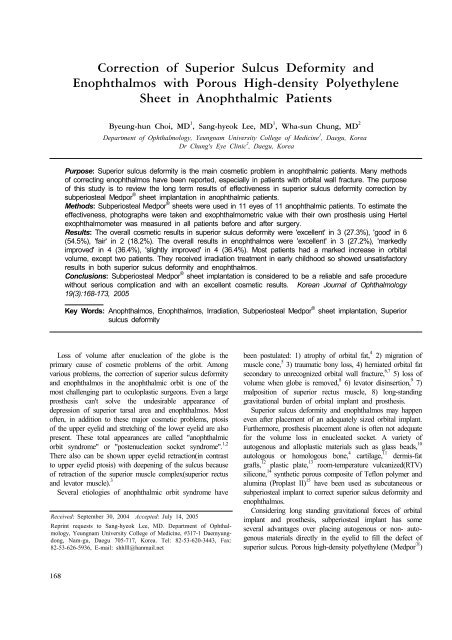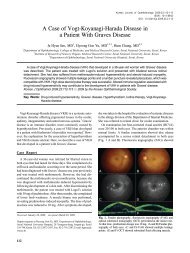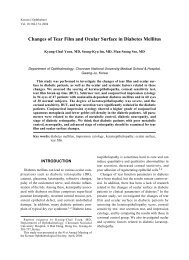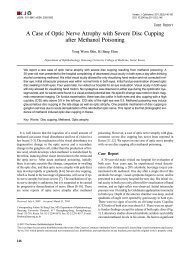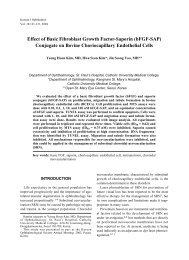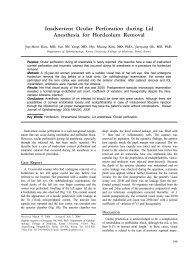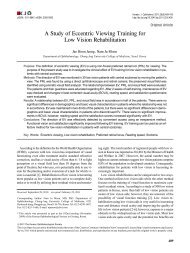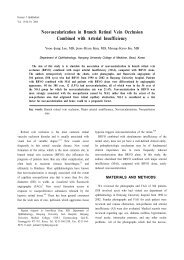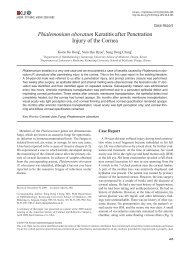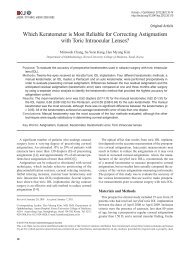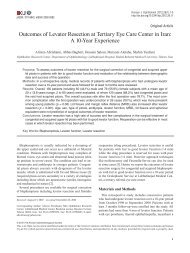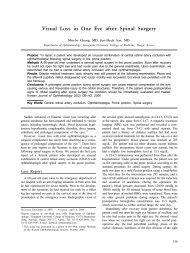Correction of Superior Sulcus Deformity and Enophthalmos with ...
Correction of Superior Sulcus Deformity and Enophthalmos with ...
Correction of Superior Sulcus Deformity and Enophthalmos with ...
You also want an ePaper? Increase the reach of your titles
YUMPU automatically turns print PDFs into web optimized ePapers that Google loves.
Department <strong>of</strong> Ophthalmology, Yeungnam University College <strong>of</strong> Medicine 1 , Daegu, KoreaDr Chung's Eye Clinic 2 , Daegu, KoreaPurpose: <strong>Superior</strong> sulcus deformity is the main cosmetic problem in anophthalmic patients. Many methods<strong>of</strong> correcting enophthalmos have been reported, especially in patients <strong>with</strong> orbital wall fracture. The purpose<strong>of</strong> this study is to review the long term results <strong>of</strong> effectiveness in superior sulcus deformity correction bysubperiosteal Medpor ® sheet implantation in anophthalmic patients.Methods: Subperiosteal Medpor ® sheets were used in 11 eyes <strong>of</strong> 11 anophthalmic patients. To estimate theeffectiveness, photographs were taken <strong>and</strong> exophthalmometric value <strong>with</strong> their own prosthesis using Hertelexophthalmometer was measured in all patients before <strong>and</strong> after surgery.Results: The overall cosmetic results in superior sulcus deformity were 'excellent' in 3 (27.3%), 'good' in 6(54.5%), 'fair' in 2 (18.2%). The overall results in enophthalmos were 'excellent' in 3 (27.2%), 'markedlyimproved' in 4 (36.4%), 'slightly improved' in 4 (36.4%). Most patients had a marked increase in orbitalvolume, except two patients. They received irradiation treatment in early childhood so showed unsatisfactoryresults in both superior sulcus deformity <strong>and</strong> enophthalmos.Conclusions: Subperiosteal Medpor ® sheet implantation is considered to be a reliable <strong>and</strong> safe procedure<strong>with</strong>out serious complication <strong>and</strong> <strong>with</strong> an excellent cosmetic results. Korean Journal <strong>of</strong> Ophthalmology19(3):168-173, 2005Key Words: Anophthalmos, <strong>Enophthalmos</strong>, Irradiation, Subperiosteal Medpor ® sheet implantation, <strong>Superior</strong>sulcus deformityLoss <strong>of</strong> volume after enucleation <strong>of</strong> the globe is theprimary cause <strong>of</strong> cosmetic problems <strong>of</strong> the orbit. Amongvarious problems, the correction <strong>of</strong> superior sulcus deformity<strong>and</strong> enophthalmos in the anophthalmic orbit is one <strong>of</strong> themost challenging part to oculoplastic surgeons. Even a largeprosthesis can't solve the undesirable appearance <strong>of</strong>depression <strong>of</strong> superior tarsal area <strong>and</strong> enophthalmos. Most<strong>of</strong>ten, in addition to these major cosmetic problems, ptosis<strong>of</strong> the upper eyelid <strong>and</strong> stretching <strong>of</strong> the lower eyelid are alsopresent. These total appearances are called "anophthalmicorbit syndrome" or "postenucleation socket syndrome". 1,2There also can be shown upper eyelid retraction(in contrastto upper eyelid ptosis) <strong>with</strong> deepening <strong>of</strong> the sulcus because<strong>of</strong> retraction <strong>of</strong> the superior muscle complex(superior rectus<strong>and</strong> levator muscle). 3Several etiologies <strong>of</strong> anophthalmic orbit syndrome haveReceived: September 30, 2004 Accepted: July 14, 2005Reprint requests to Sang-hyeok Lee, MD. Department <strong>of</strong> Ophthalmology,Yeungnam University College <strong>of</strong> Medicine, #317-1 Daemyungdong,Nam-gu, Daegu 705-717, Korea. Tel: 82-53-620-3443, Fax:82-53-626-5936, E-mail: shhlll@hanmail.netbeen postulated: 1) atrophy <strong>of</strong> orbital fat, 4 2) migration <strong>of</strong>muscle cone, 5 3) traumatic bony loss, 4) herniated orbital fatsecondary to unrecognized orbital wall fracture, 6,7 5) loss <strong>of</strong>volume when globe is removed, 8 6) levator disinsertion, 9 7)malposition <strong>of</strong> superior rectus muscle, 8) long-st<strong>and</strong>inggravitational burden <strong>of</strong> orbital implant <strong>and</strong> prosthesis.<strong>Superior</strong> sulcus deformity <strong>and</strong> enophthalmos may happeneven after placement <strong>of</strong> an adequately sized orbital implant.Furthermore, prosthesis placement alone is <strong>of</strong>ten not adequatefor the volume loss in enucleated socket. A variety <strong>of</strong>autogenous <strong>and</strong> alloplastic materials such as glass beads, 10autologous or homologous bone, 4 cartilage, 11 dermis-fatgrafts, 12 plastic plate, 13 room-temperature vulcanized(RTV)silicone, 14 synthetic porous composite <strong>of</strong> Teflon polymer <strong>and</strong>alumina (Proplast II) 15 have been used as subcutaneous orsubperiosteal implant to correct superior sulcus deformity <strong>and</strong>enophthalmos.Considering long st<strong>and</strong>ing gravitational forces <strong>of</strong> orbitalimplant <strong>and</strong> prosthesis, subperiosteal implant has someseveral advantages over placing autogenous or non- autogenousmaterials directly in the eyelid to fill the defect <strong>of</strong>superior sulcus. Porous high-density polyethylene (Medpor )
implants are useful because they are easily inserted into thesubperiosteal space <strong>and</strong> provide appropriate long st<strong>and</strong>ingvolume augmentation to push the orbital contents superiorly<strong>and</strong> anteriorly.To estimate the effectiveness <strong>of</strong> correcting superior sulcusdeformity <strong>and</strong> enophthalmos, Medpor sheets were used asa subperiosteal implant in a total <strong>of</strong> 11 anophthalmic patientsin this study. The indication for this procedure was patientswho showed superior sulcus deformity <strong>and</strong> enophthalmosdespite the prior insertion <strong>of</strong> an adequately sized orbitalimplant <strong>and</strong> prosthesis. The study was designed retrospectively to estimate longterm effectiveness <strong>of</strong> subperiosteal Medpor sheetimplantation in anophthalmic orbit. We reviewed hospitalrecords <strong>of</strong> 11 anophthalmic patients who underwent volumeaugmentation surgery <strong>with</strong> Medpor sheet between August1997 <strong>and</strong> March 2004. The patients were selected for surgeryon the basis <strong>of</strong> poor cosmesis owing to the presence <strong>of</strong> adeep upper eyelid sulcus <strong>and</strong> enophthalmos despite thepresence <strong>of</strong> an adequately sized orbital implant <strong>and</strong>prosthesis.Photographs were taken in all patients to compare degree<strong>of</strong> superior sulcus deformity <strong>and</strong> exophthalmometric value<strong>with</strong> their own prosthesis was assessed to measureenophthalmos using Hertel exophthalmometer preoperatively.The volume <strong>and</strong> structure <strong>of</strong> the implant, surroundingextraocular muscles, s<strong>of</strong>t tissue <strong>and</strong> possible orbital wallfracture were carefully examined by using computerizedtomographic scans <strong>and</strong> ultrasonography in some cases.In 8 <strong>of</strong> 11 patients, volume augmentation surgery wasdone under general anesthesia via subciliary incision <strong>and</strong> inother 3 patients under local anesthesia via transconjunctivalapproach. The prosthesis was removed , washed in a sterilesaline before surgical preparation. After the incision to theperiosteum was made <strong>with</strong> 15 Bard-Parker blade, a Freerperiosteal elevator was used to dissect a subperiosteal pocketwhich includes the floor mainly, the lateral wall <strong>and</strong> the ro<strong>of</strong>if needed. The 1.5 mm thickness Medpor sheets werecarved using scalpel <strong>and</strong> Mayo scissors to proper size <strong>and</strong>then placed into the subperiosteal space. Several pieces <strong>of</strong>proper sized Medpor sheet were added according to amount<strong>of</strong> enophthalmos. Once the position <strong>of</strong> Medpor sheets weresatisfactory, the periosteum was closed <strong>with</strong> interruptedsutures <strong>with</strong> 5/0 nylon. If there was accompanying eyelidmalposition, correcting procedure was done simultaneously orconsecutively. Topical antibiotic ointment was applied to thewound <strong>and</strong> systemic antibiotics were given to the patients fora week.Postoperative assessments were made <strong>with</strong> their ownprosthesis including photograph <strong>and</strong> exophthalmometricvalue. Photographs were taken to compare degree <strong>of</strong> superiorsulcus deformity <strong>and</strong> exophthalmometric value was measuredby Hertel exophthalmometer. To evaluate improvement <strong>of</strong>superior sulcus deformity by preoperative <strong>and</strong> postoperativephotographs, the patients' appearance was graded as follows:Grade 1 = marked difference compared <strong>with</strong> unaffected side<strong>and</strong> no postoperative improvement <strong>of</strong> affected side (poor),Grade 2 = moderate difference compared <strong>with</strong> unaffected side<strong>and</strong> slight postoperative improvement <strong>of</strong> affected side (fair),Grade 3 = slight difference compared <strong>with</strong> unaffected side<strong>and</strong> marked postoperative improvement <strong>of</strong> affected side(good), Grade 4 = no difference compared <strong>with</strong> the unaffectedside(excellent). To estimate improvement <strong>of</strong> enophthalmos,exophthalmometric values also defined as 1-4 grades asfollows: Grade 1 = no postoperative improvement, Grade 2 =postoperative exophthalmometric value improvement
unsatisfactory results. But the other patient who underwentirradiation at the age <strong>of</strong> 5 showed satisfactory improvementin both superior sulcus deformity <strong>and</strong> enophthalmos.Most patients had a marked increase in orbital volume, asshown by the improvement <strong>of</strong> the upper eyelid sulcusdeformity <strong>and</strong> enophthalmos (Fig. 1-3). All patients in thisstudy tolerated well <strong>with</strong>out intraoperative complications <strong>and</strong>there was no postoperative complications such as orbitalhemorrhage, infection <strong>and</strong> infraorbital hypoesthesia. In allcases, postoperative pain was mild <strong>and</strong> easily controlled <strong>with</strong>analgesics. In no case extrusion or migration <strong>of</strong> the implantoccurred during follow up period.Deep superior sulcus deformity <strong>and</strong> enophthalmos is acommon problem in anophthalmic patients. Devoe 4 describeddeepening <strong>of</strong> the superior sulcus in anophthalmic patientsoccurred due to malposition <strong>of</strong> the superior rectus muscle tothe levator muscle that pulls the levator posteriorly instead<strong>of</strong> superiorly. In 1976, Vistnes 1 added upperlid <strong>and</strong> lowerlidptosis to enophthalmos <strong>with</strong> superior sulcus deformity <strong>and</strong>named “anophthalmic orbital syndrome”. He suggested thatchronic gravitational forces <strong>of</strong> the prosthesis might leaddownward shift <strong>of</strong> the orbital contents <strong>and</strong> produced upperlidptosis. In 1982, Tyers <strong>and</strong> Collin 2 first described“postenucleation socket syndrome” composed <strong>of</strong> totalappearance <strong>of</strong> enophthalmos, deepening <strong>of</strong> the upper eyelidsulcus, ptosis <strong>of</strong> the upper eyelid <strong>and</strong> stretching <strong>of</strong> the lowereyelid. Smit et al 3 reviewed 22 cases <strong>of</strong> CT scan <strong>of</strong> the orbit<strong>and</strong> indicated different point <strong>of</strong> previously decribedpostenucleation socket syndrome. The reviewed casesrevealed retraction <strong>of</strong> upper eyelid in contrast to ptosis. Ptosis<strong>of</strong> the upper eyelid <strong>and</strong> fat atrophy was not observed, butrather, retraction <strong>of</strong> the superior muscle complex was notedto produce deepening <strong>of</strong> the sulcus <strong>and</strong> retraction <strong>of</strong> theupper eyelid. In our study, we noticed 2 cases <strong>of</strong> upper eyelidretraction <strong>and</strong> they needed recession <strong>of</strong> levator muscle.Sometimes, prosthesis placement alone is <strong>of</strong>ten notadequate for the s<strong>of</strong>t tissue loss in anophthalmic patients. Thevolume <strong>of</strong> an adult globe is approximately 8 cm 3 . Besides the8 cm 3 volume loss through enucleation, there can beadditional s<strong>of</strong>t tissue loss <strong>of</strong> 4 cm 3 , resulting in a totaldecreased volume <strong>of</strong> 12 cm 3 . The volume replaced by a 20mm spherical implant approaches only 4 cm 3 . A prosthesismay give an additional 1.5 to 4 cm 3 , therefore providing atotal 5.5 to 8 cm 3 <strong>of</strong> orbital volume replacement, but stillremain 4 to 6.5 cm 3 deficit. If there is herniation <strong>of</strong> fat <strong>and</strong>displacement <strong>of</strong> the orbital wall, this discrepancy may bemore prominent. 16 In the case <strong>of</strong> evisceration, the severity <strong>of</strong>enophthalmos <strong>and</strong> superior sulcus deformity can be mild, butcan also happen because <strong>of</strong> migration <strong>of</strong> orbital implant,atrophy <strong>of</strong> surrounding tissue <strong>and</strong> weight <strong>of</strong> implant.The correction <strong>of</strong> this sunken eye appearance <strong>with</strong> upper<strong>and</strong> lower lid malposition has been a chief issue to
oculoplastic surgeons, <strong>and</strong> many surgical techniques havebeen tried since Mules 17 first attempted to replace theeviscerated eyeball <strong>with</strong> a artificial vitreous in 1885.Anophthalmic superior sulcus deformity can be addressed bya variety <strong>of</strong> techniques, including intraconal implants,subperiosteal implants or through direct augmentation <strong>of</strong> thesuperior sulcus. Direct augmentation <strong>of</strong> superior sulcus usingfree fat or dermis-fat graft, Alloderm , temporoparietal fasciahas been described for many years. However when usinggraft materials, resorption may happen <strong>with</strong> time <strong>and</strong>temporoparietal fascia flap surgery involve more complexsurgery. Volume augmentation surgery for anophthalmicpatients via subperiosteal pocket has several advantages overdirect subcutaneous volume replacement. It may improveboth enophthalmos <strong>and</strong> superior sulcus deformity, <strong>and</strong> mayimprove upper eyelid ptosis in certain cases. In enophthalmoscorrection, subperiosteal implant transplantation waseffectively utilized for posttraumatic enophthalmos 18,19 <strong>and</strong>anophthalmic enophthalmos. 18 Replacement <strong>of</strong> lost volumehas employed various materials, including glass beads, 10autologous or homologous bone, 4 cartilage, 11 <strong>and</strong> dermis, 12assorted plastic plate, 13 room-temperature vulcanized(RTV)silicone, 14 synthetic porous composite <strong>of</strong> Teflon polymer <strong>and</strong>alumina. 15 The authors used porous polyethylene sheetalready successfully used in orbital <strong>and</strong> crani<strong>of</strong>acialreconstruction during the past years. "Porous" or "integrated"implants are the most important graft used for orbitalreconstructive surgery in recent years, <strong>with</strong> porouspolyethylene <strong>and</strong> hydroxyapatite being the most common.Their porous structure allows for rapid vascular, s<strong>of</strong>t-tissue<strong>and</strong> bone ingrowth that serves to stabilize the implant inrelation to the surrounding tissue. Porous polyethylene is ahighly biocompatible, durable <strong>and</strong> remarkably stablealloplast. 20 Technically, it is easy to work, strong yetsomewhat flexible <strong>and</strong> <strong>of</strong>fers possibility <strong>of</strong> obtaining aprecise three-dimensional shape.In our study, superior sulcus deformity <strong>and</strong> enophthalmoswas successfully corrected in most patients <strong>with</strong>outcomplications. Two patients <strong>with</strong> retinoblastoma whoreceived additional irradiation treatment in their childhoodshowed unsatisfactory cosmetic results (Grade 2). It ispresumed that irradiation-induced slowing <strong>of</strong> bone growthcan lead to a noticeable asymmetry in relative size <strong>and</strong>volume <strong>of</strong> the bony orbit <strong>and</strong> thus accentuating theappearance <strong>of</strong> enophthalmos. 21 Furthermore, contraction orscarring <strong>of</strong> orbital s<strong>of</strong>t tissue induced by irradiation can makethe enophthalmos more prominent, so that the results <strong>of</strong>subperiosteal implantation <strong>of</strong> Medpor sheets were notsufficient. There were 2 patients who showed improvement<strong>of</strong> upper eyelid ptosis <strong>with</strong>out additional lid surgery norexchanging their own prosthesis. We think that the volumedeficit should be corrected first before upper eyelid ptosissurgery because an added orbital volume has some effects <strong>of</strong>pushing upward the upper eyelid.In summary, subperiosteal implantation <strong>of</strong> porous highdensitypolyethylene sheet for anophthalmic patients <strong>with</strong>
superior sulcus deformity <strong>and</strong> enophthalmos is shown to bea reliable <strong>and</strong> safe procedure <strong>with</strong> an excellent cosmeticresults <strong>and</strong> <strong>with</strong>out serious complications1. Vistnes LM. Mechanism <strong>of</strong> upper lid ptosis in theanophthalmic orbit. Plast Reconstr Surg 1976;58:539-45.2. Tyers AC, Collin JR. Orbital implants <strong>and</strong> post enucleationsocket syndrome. Trans Ophthalmol Soc UK 1982;102:90-2.3. Smit TJ, Koornneef L, Zonneveld FW, et al. Computedtomography in the assessment <strong>of</strong> the postenucleation socketsyndrome. Ophthalmology 1990;97:1347-51.4. Devoe AG. Experiences <strong>with</strong> the surgery <strong>of</strong> theanophthalmic orbit. Am J Ophthalmol 1945;28:1346-51.5. Bello VM, Levine MR. <strong>Superior</strong> sulcus deformity. ArchOphthalmol 1980;98:2215-6.6. Pfeiffer RL. Traumatic enophthalmos. Adv Ophthalmic PlastReconstr Surg 1987;6:301-12.7. Pfeiffer RL. Roentgenography <strong>of</strong> exophthalmos. Trans AmOphthalmol Soc 1941;39:492-559.8. Stone W Jr. Complications <strong>of</strong> evisceration <strong>and</strong> enucleation.In : Fasanella RM, ed. Complications in Eye Surgery, 2nded. Philadelphia: Saunders, 1965;388-425.9. Pearl RM. Acquired ptosis: a reexamination <strong>of</strong> etiology <strong>and</strong>treatment. Plast Reconstr Surg 1985;76:56-64.10. Smith B, Obear M, Leone CR. The correction <strong>of</strong>enophthalmos associated <strong>with</strong> by glass bead implantation.Am J Ophthalmol 1967;64:1088-93.11. Zbylski JK. <strong>Correction</strong> <strong>of</strong> lower eyelid ptosis in theanophthalmic socket <strong>with</strong> an autogenous ear cartilage graft.Plast Reconstr Surg 1977;61:220-3.12. Van Gemert JV, Leone CR Jr. <strong>Correction</strong> <strong>of</strong> a deepsuperior sulcus <strong>with</strong> dermis-fat implantation. ArchOphthalmol 1986;104:604-7.13. Sugar HS, Forrester HJ. Methacrylic resin implants forsunken upper eyelid following enucleation. Am JOphthalmol 1946;29:993-1000.14. Sergott TJ, Vistnes LM. <strong>Correction</strong> <strong>of</strong> enophthalmos <strong>and</strong>superior sulcus depression in the anophthalmic orbit: along-term follow-up. Plast Reconstr Surg 1987;79:331-8.15. Shah S, Rhatigan M, Sampath R, et al. Use <strong>of</strong> Proplast IIas a subperiosteal implant for the correction <strong>of</strong> anophthalmicenophthalmos. Br J Ophthalmol 1995;79:830-3.16. Meleca RJ, Mathog RH. Bone graft implantation forcorrection <strong>of</strong> the anophthalmic orbit. Arch OtolaryngolHead Neck Surg 1994;120:49-55.17. Mules PH. Evisceration <strong>of</strong> the globe <strong>with</strong> artificial vitreous.Adv Ophthalmic Plast Reconstr Surg 1990;8:69-72.18. Kim BJ, Kim YD. Medpor R enophthalmos wedge implantsin enophthalmos correction. J Korean Ophthalmol Soc2002;43:1559-69.19. Lee MS, Lew HL, Lee SY. The results <strong>of</strong> delayed repairfor orbital wall fracture. J Korean Ophthalmol Soc1998;39:1049-54.20. Karesh JW, Dresner SC. High-density porous polyethylene(Medpor R ) as a successful anophthalmic socket implant.Ophthalmology 1994;101:1695-6.21. Baylis HI, Call NB. Severe enophthalmos followingirradiation <strong>of</strong> the anophthalmic socket: surgical approaches.Ophthalmology 1979;86:1647-54.


